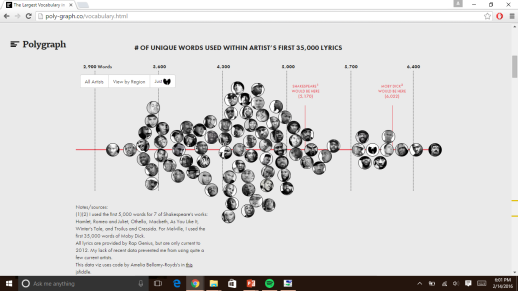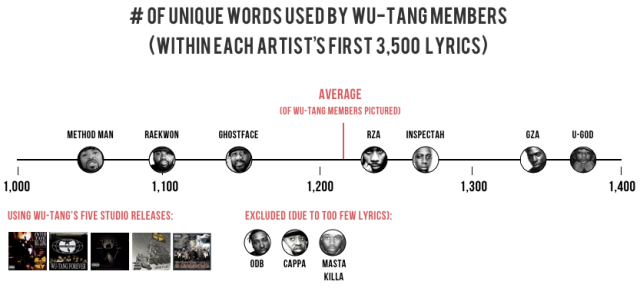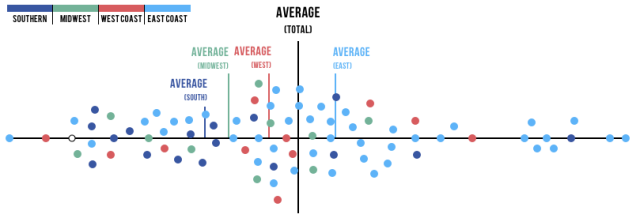Data visualization has become a critical form of digital disruption used by journalists to convey messages in a manner more effective than a long article. Since its original inception by John Snow, and his tracking of cholera in the 19th century, data journalism has become an asset in news. The Data Journalism Handbook states that data visualization and “data journalism can help a journalist tell a complex story through engaging infographics.” In order to get a better idea about how data journalism and visualization can be effective in the realm of journalism, I searched for an example in music industry.
Hip-hop is perhaps the genre that takes lyricism more seriously than any other musical style. Not only do rhyme scheme and flow matter tremendously, but an artist’s vocabulary is also judged by critics and peers. When searching for an interesting article about data visualization in the music industry, I recalled an interesting article I stumbled upon on reddit regarding the vocabulary of hip-hop artists.
The Largest Vocabulary in Hip Hop by Matt Daniels was produced on the blog Polygraph. In this article, Daniels references the broad vocabulary of Shakespeare and decides to pit the greatest rappers of all time against the literary genius in regards to shear vocabulary. Using each artist’s first 35,000 lyrics, this is the data that Daniels found:

Based on his work, Daniels discovered many interesting findings. Namely, the old Wu-Tang Clan adage remains true: Wu-Tang Clan Aint Nothin Ta F*ck Wit. The infamous hip hop collective ranks #2 in unique vocabulary and its individual members received rankings ranging from #2 (U-God) to #23 (Method Man), overall ranking far ahead of Shakespeare in regards to unique words used within an artist’s first 35,000 lyrics.

Other interesting information includes the surprisingly underwhelming vocabularies of hip-hop legends Lil’ Wayne, 2Pac, Snoop Dogg (Lion?), and the infamous Kanye West. 
These infographics were surrounded by written analysis to ensure a thorough understanding of the visual data being presented and overall this piece was highly engaging. The first major visual was interactive and painted an easy to understand picture of artist’s unique vocabulary, while subsequent infographics broke down the data further to help garner a further understanding of the data. This included in-depth analysis of each region of the data set, artist breakdowns, and even regional breakdowns of the United States, which showed that the South had the lowest average vocabulary and the East Coast had the highest.

So, did Matt Daniels effectively drive his message about the Largest Vocabulary in Hip Hop using unique visual journalism and data? Simply put, yes. Daniels utilized visual data to his benefit by making several easy-to-process charts and deciding against using motion graphics that might muddle his message. Daniels also goes beyond a simple mapping of data that was used by John Snow, rather adopting a mathematical based chart with clear data points to articulate his message. However, the data could have been more interactive. While clicking on the faces of rappers across his chart, only their names and word-count appear. It would be interesting to see the discography used to get this data or further information on the artist.
Overall, it would be hard to find any hip-hop head, like me, displeased with this form of data journalism. This method of delivering information encapsulates visual learners that might struggle to engage with lengthy written articles and provides enough written analysis to warrant the engagement of a more prolific reader. This healthy balance is something that I believe should be struck in data journalism, just the right amount of words and data to tell a whole story and engage all audiences. I align with The Data Journalism Handbook’s concept that data is simply part of telling a whole journalistic story, and I believe Daniels achieves this with his work on hip hop vocabulary.
